Analyzing Negotiation Skills and Post-Pitch Obligations
VerifiedAdded on 2020/10/23
|15
|4570
|320
AI Summary
The given report provides an analysis of negotiation skills, which helps organizations understand each other's perspectives and respect thinking. It also covers the pitch process used by companies to advertise their requirements in the market. The report discusses possible post-pitch obligations that arise during this process. By examining these aspects, students can gain a deeper understanding of effective negotiation strategies and their importance in business.
Contribute Materials
Your contribution can guide someone’s learning journey. Share your
documents today.
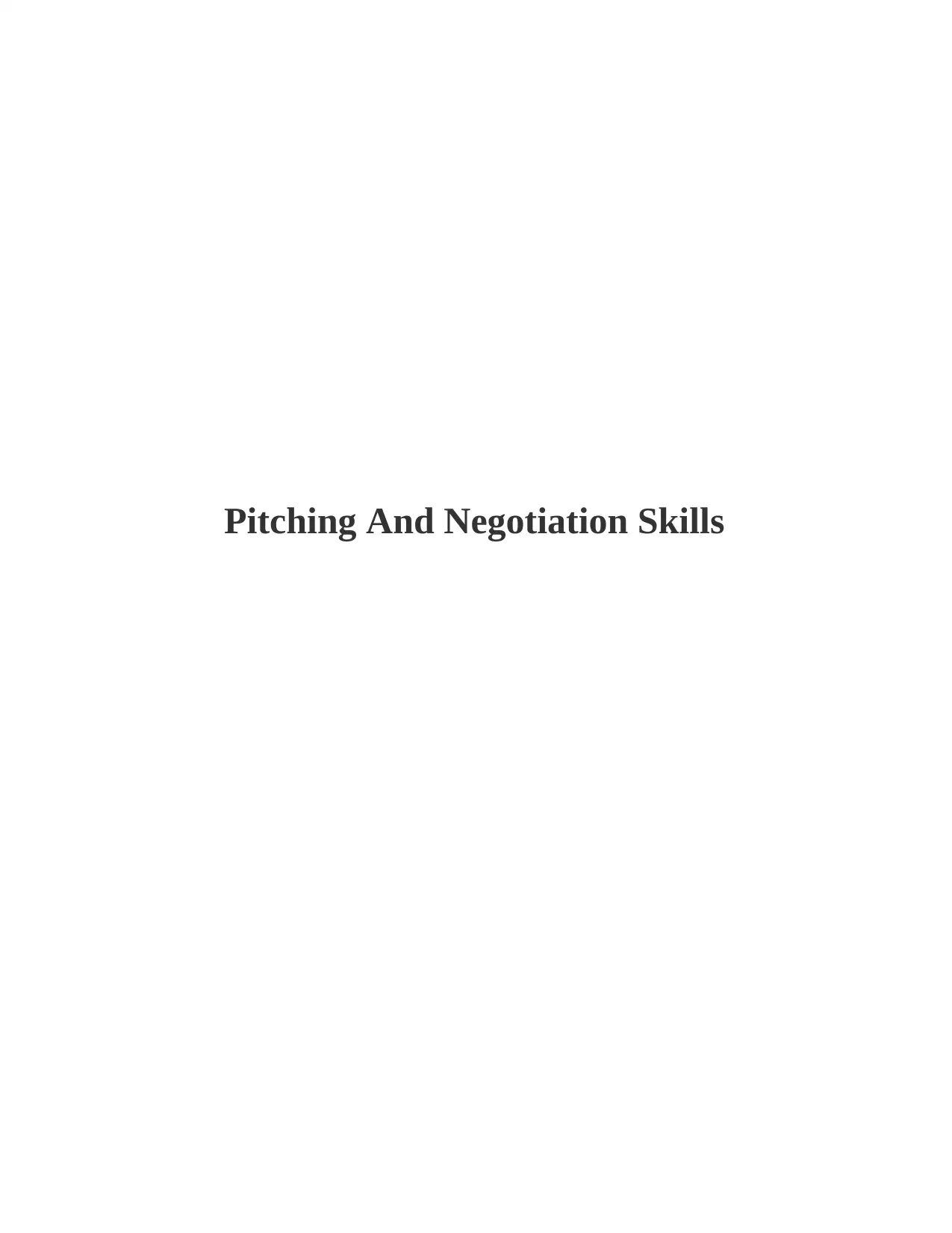
Pitching And Negotiation Skills
Secure Best Marks with AI Grader
Need help grading? Try our AI Grader for instant feedback on your assignments.
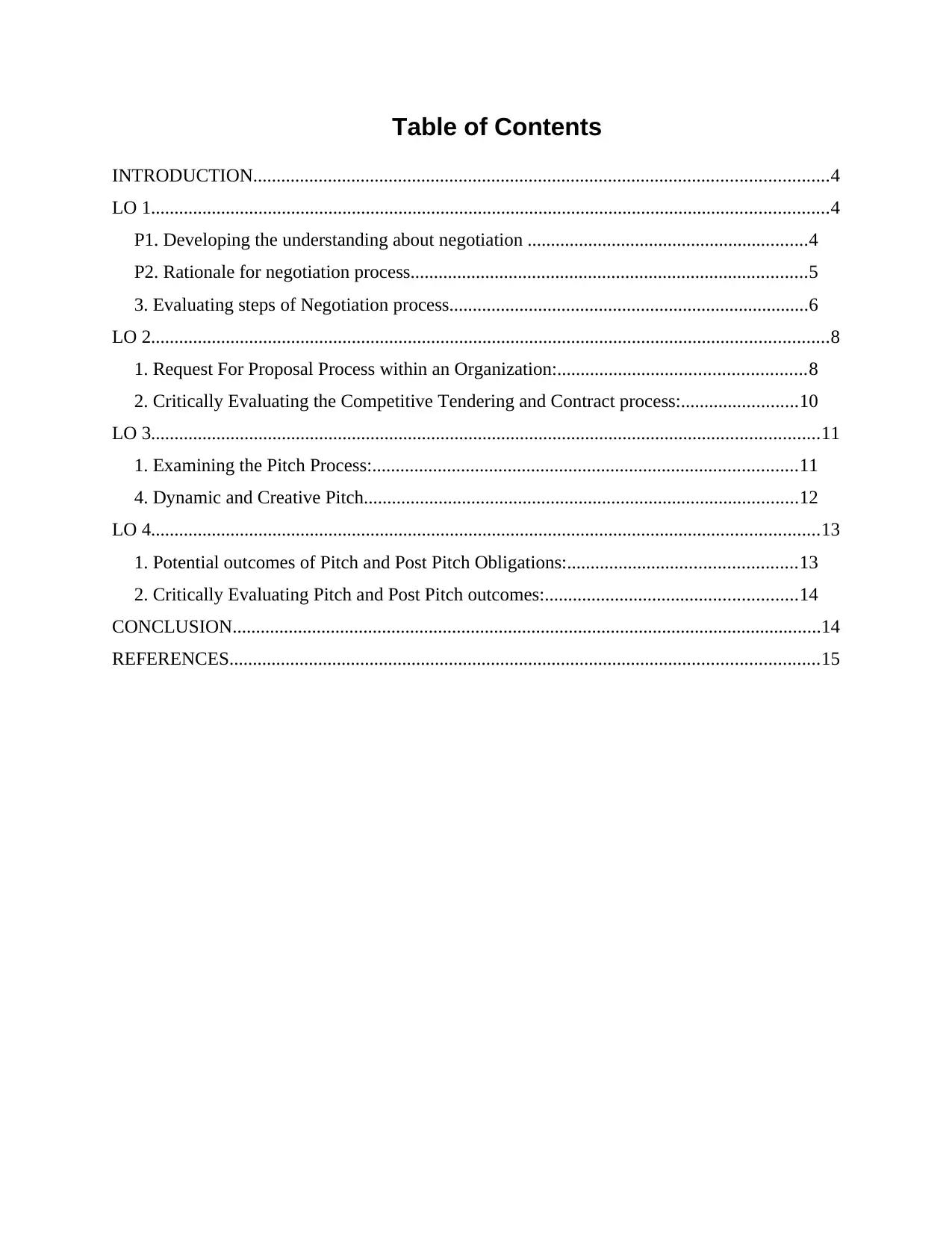
Table of Contents
INTRODUCTION...........................................................................................................................4
LO 1.................................................................................................................................................4
P1. Developing the understanding about negotiation ............................................................4
P2. Rationale for negotiation process.....................................................................................5
3. Evaluating steps of Negotiation process.............................................................................6
LO 2.................................................................................................................................................8
1. Request For Proposal Process within an Organization:.....................................................8
2. Critically Evaluating the Competitive Tendering and Contract process:.........................10
LO 3...............................................................................................................................................11
1. Examining the Pitch Process:...........................................................................................11
4. Dynamic and Creative Pitch.............................................................................................12
LO 4...............................................................................................................................................13
1. Potential outcomes of Pitch and Post Pitch Obligations:.................................................13
2. Critically Evaluating Pitch and Post Pitch outcomes:......................................................14
CONCLUSION..............................................................................................................................14
REFERENCES..............................................................................................................................15
INTRODUCTION...........................................................................................................................4
LO 1.................................................................................................................................................4
P1. Developing the understanding about negotiation ............................................................4
P2. Rationale for negotiation process.....................................................................................5
3. Evaluating steps of Negotiation process.............................................................................6
LO 2.................................................................................................................................................8
1. Request For Proposal Process within an Organization:.....................................................8
2. Critically Evaluating the Competitive Tendering and Contract process:.........................10
LO 3...............................................................................................................................................11
1. Examining the Pitch Process:...........................................................................................11
4. Dynamic and Creative Pitch.............................................................................................12
LO 4...............................................................................................................................................13
1. Potential outcomes of Pitch and Post Pitch Obligations:.................................................13
2. Critically Evaluating Pitch and Post Pitch outcomes:......................................................14
CONCLUSION..............................................................................................................................14
REFERENCES..............................................................................................................................15

Illustration Index
Illustration 1: Negotiation Process...................................................................................................8
Illustration 2: Steps of Request for Proposal (RFP) Process.........................................................10
Illustration 1: Negotiation Process...................................................................................................8
Illustration 2: Steps of Request for Proposal (RFP) Process.........................................................10
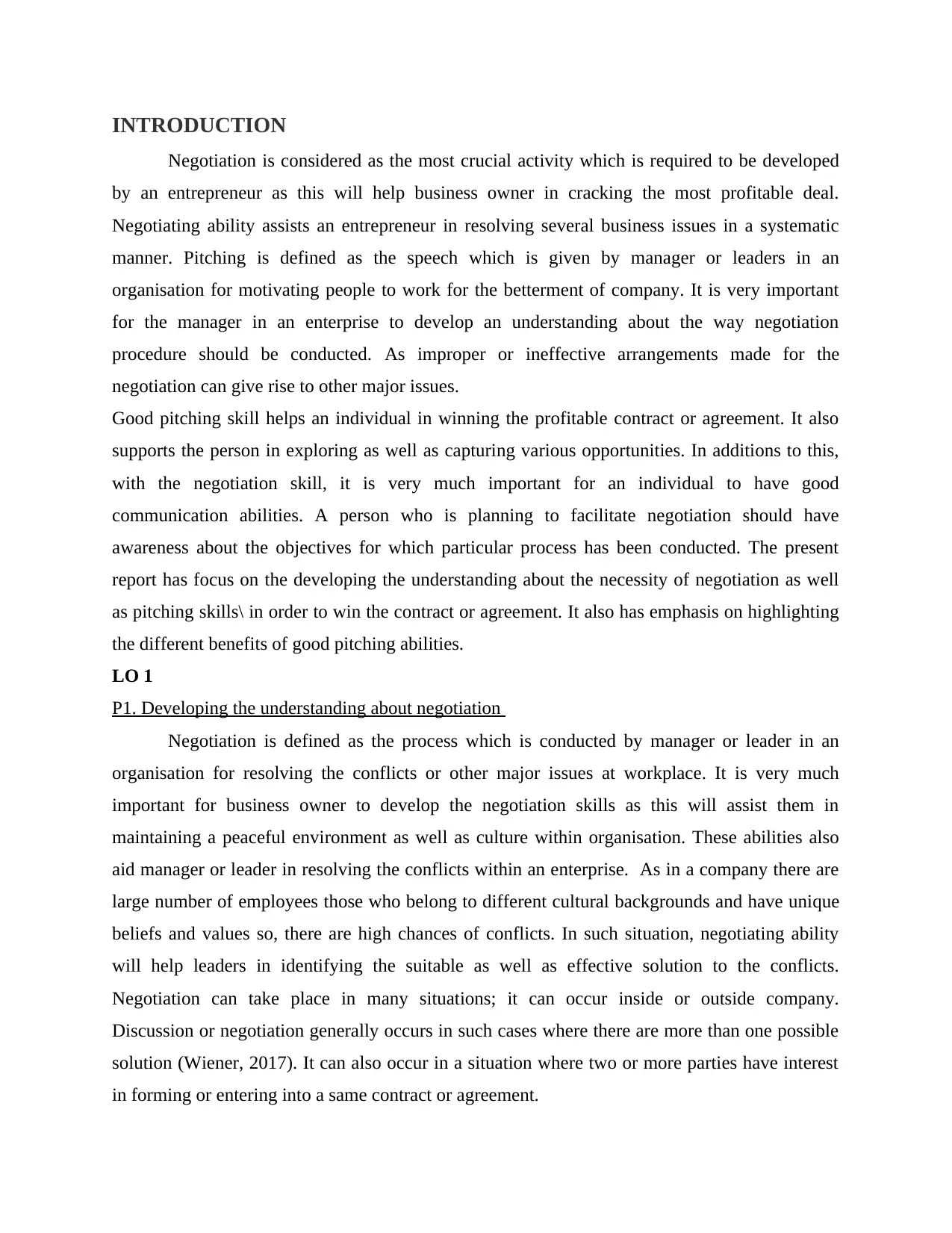
INTRODUCTION
Negotiation is considered as the most crucial activity which is required to be developed
by an entrepreneur as this will help business owner in cracking the most profitable deal.
Negotiating ability assists an entrepreneur in resolving several business issues in a systematic
manner. Pitching is defined as the speech which is given by manager or leaders in an
organisation for motivating people to work for the betterment of company. It is very important
for the manager in an enterprise to develop an understanding about the way negotiation
procedure should be conducted. As improper or ineffective arrangements made for the
negotiation can give rise to other major issues.
Good pitching skill helps an individual in winning the profitable contract or agreement. It also
supports the person in exploring as well as capturing various opportunities. In additions to this,
with the negotiation skill, it is very much important for an individual to have good
communication abilities. A person who is planning to facilitate negotiation should have
awareness about the objectives for which particular process has been conducted. The present
report has focus on the developing the understanding about the necessity of negotiation as well
as pitching skills\ in order to win the contract or agreement. It also has emphasis on highlighting
the different benefits of good pitching abilities.
LO 1
P1. Developing the understanding about negotiation
Negotiation is defined as the process which is conducted by manager or leader in an
organisation for resolving the conflicts or other major issues at workplace. It is very much
important for business owner to develop the negotiation skills as this will assist them in
maintaining a peaceful environment as well as culture within organisation. These abilities also
aid manager or leader in resolving the conflicts within an enterprise. As in a company there are
large number of employees those who belong to different cultural backgrounds and have unique
beliefs and values so, there are high chances of conflicts. In such situation, negotiating ability
will help leaders in identifying the suitable as well as effective solution to the conflicts.
Negotiation can take place in many situations; it can occur inside or outside company.
Discussion or negotiation generally occurs in such cases where there are more than one possible
solution (Wiener, 2017). It can also occur in a situation where two or more parties have interest
in forming or entering into a same contract or agreement.
Negotiation is considered as the most crucial activity which is required to be developed
by an entrepreneur as this will help business owner in cracking the most profitable deal.
Negotiating ability assists an entrepreneur in resolving several business issues in a systematic
manner. Pitching is defined as the speech which is given by manager or leaders in an
organisation for motivating people to work for the betterment of company. It is very important
for the manager in an enterprise to develop an understanding about the way negotiation
procedure should be conducted. As improper or ineffective arrangements made for the
negotiation can give rise to other major issues.
Good pitching skill helps an individual in winning the profitable contract or agreement. It also
supports the person in exploring as well as capturing various opportunities. In additions to this,
with the negotiation skill, it is very much important for an individual to have good
communication abilities. A person who is planning to facilitate negotiation should have
awareness about the objectives for which particular process has been conducted. The present
report has focus on the developing the understanding about the necessity of negotiation as well
as pitching skills\ in order to win the contract or agreement. It also has emphasis on highlighting
the different benefits of good pitching abilities.
LO 1
P1. Developing the understanding about negotiation
Negotiation is defined as the process which is conducted by manager or leader in an
organisation for resolving the conflicts or other major issues at workplace. It is very much
important for business owner to develop the negotiation skills as this will assist them in
maintaining a peaceful environment as well as culture within organisation. These abilities also
aid manager or leader in resolving the conflicts within an enterprise. As in a company there are
large number of employees those who belong to different cultural backgrounds and have unique
beliefs and values so, there are high chances of conflicts. In such situation, negotiating ability
will help leaders in identifying the suitable as well as effective solution to the conflicts.
Negotiation can take place in many situations; it can occur inside or outside company.
Discussion or negotiation generally occurs in such cases where there are more than one possible
solution (Wiener, 2017). It can also occur in a situation where two or more parties have interest
in forming or entering into a same contract or agreement.
Secure Best Marks with AI Grader
Need help grading? Try our AI Grader for instant feedback on your assignments.
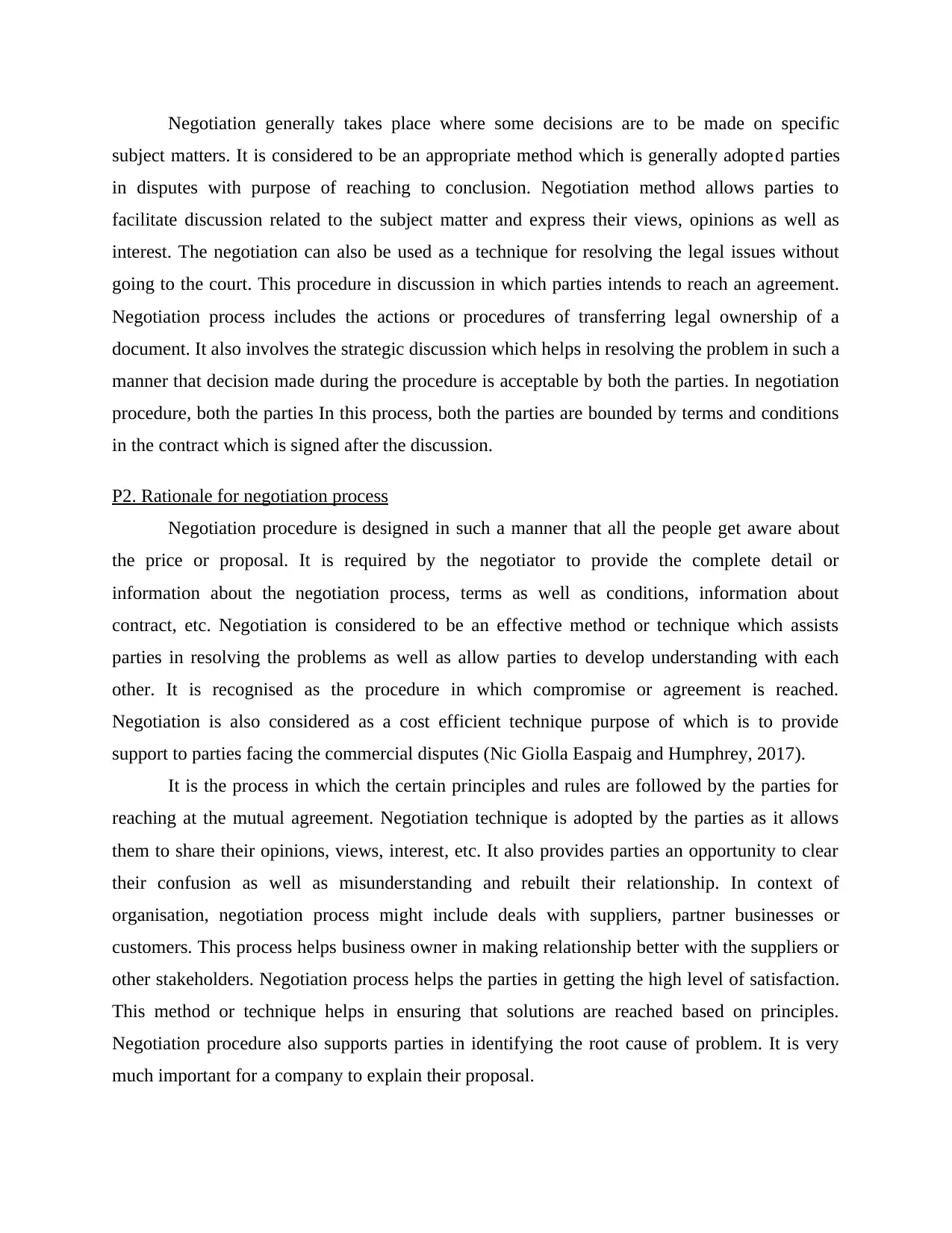
Negotiation generally takes place where some decisions are to be made on specific
subject matters. It is considered to be an appropriate method which is generally adopted parties
in disputes with purpose of reaching to conclusion. Negotiation method allows parties to
facilitate discussion related to the subject matter and express their views, opinions as well as
interest. The negotiation can also be used as a technique for resolving the legal issues without
going to the court. This procedure in discussion in which parties intends to reach an agreement.
Negotiation process includes the actions or procedures of transferring legal ownership of a
document. It also involves the strategic discussion which helps in resolving the problem in such a
manner that decision made during the procedure is acceptable by both the parties. In negotiation
procedure, both the parties In this process, both the parties are bounded by terms and conditions
in the contract which is signed after the discussion.
P2. Rationale for negotiation process
Negotiation procedure is designed in such a manner that all the people get aware about
the price or proposal. It is required by the negotiator to provide the complete detail or
information about the negotiation process, terms as well as conditions, information about
contract, etc. Negotiation is considered to be an effective method or technique which assists
parties in resolving the problems as well as allow parties to develop understanding with each
other. It is recognised as the procedure in which compromise or agreement is reached.
Negotiation is also considered as a cost efficient technique purpose of which is to provide
support to parties facing the commercial disputes (Nic Giolla Easpaig and Humphrey, 2017).
It is the process in which the certain principles and rules are followed by the parties for
reaching at the mutual agreement. Negotiation technique is adopted by the parties as it allows
them to share their opinions, views, interest, etc. It also provides parties an opportunity to clear
their confusion as well as misunderstanding and rebuilt their relationship. In context of
organisation, negotiation process might include deals with suppliers, partner businesses or
customers. This process helps business owner in making relationship better with the suppliers or
other stakeholders. Negotiation process helps the parties in getting the high level of satisfaction.
This method or technique helps in ensuring that solutions are reached based on principles.
Negotiation procedure also supports parties in identifying the root cause of problem. It is very
much important for a company to explain their proposal.
subject matters. It is considered to be an appropriate method which is generally adopted parties
in disputes with purpose of reaching to conclusion. Negotiation method allows parties to
facilitate discussion related to the subject matter and express their views, opinions as well as
interest. The negotiation can also be used as a technique for resolving the legal issues without
going to the court. This procedure in discussion in which parties intends to reach an agreement.
Negotiation process includes the actions or procedures of transferring legal ownership of a
document. It also involves the strategic discussion which helps in resolving the problem in such a
manner that decision made during the procedure is acceptable by both the parties. In negotiation
procedure, both the parties In this process, both the parties are bounded by terms and conditions
in the contract which is signed after the discussion.
P2. Rationale for negotiation process
Negotiation procedure is designed in such a manner that all the people get aware about
the price or proposal. It is required by the negotiator to provide the complete detail or
information about the negotiation process, terms as well as conditions, information about
contract, etc. Negotiation is considered to be an effective method or technique which assists
parties in resolving the problems as well as allow parties to develop understanding with each
other. It is recognised as the procedure in which compromise or agreement is reached.
Negotiation is also considered as a cost efficient technique purpose of which is to provide
support to parties facing the commercial disputes (Nic Giolla Easpaig and Humphrey, 2017).
It is the process in which the certain principles and rules are followed by the parties for
reaching at the mutual agreement. Negotiation technique is adopted by the parties as it allows
them to share their opinions, views, interest, etc. It also provides parties an opportunity to clear
their confusion as well as misunderstanding and rebuilt their relationship. In context of
organisation, negotiation process might include deals with suppliers, partner businesses or
customers. This process helps business owner in making relationship better with the suppliers or
other stakeholders. Negotiation process helps the parties in getting the high level of satisfaction.
This method or technique helps in ensuring that solutions are reached based on principles.
Negotiation procedure also supports parties in identifying the root cause of problem. It is very
much important for a company to explain their proposal.
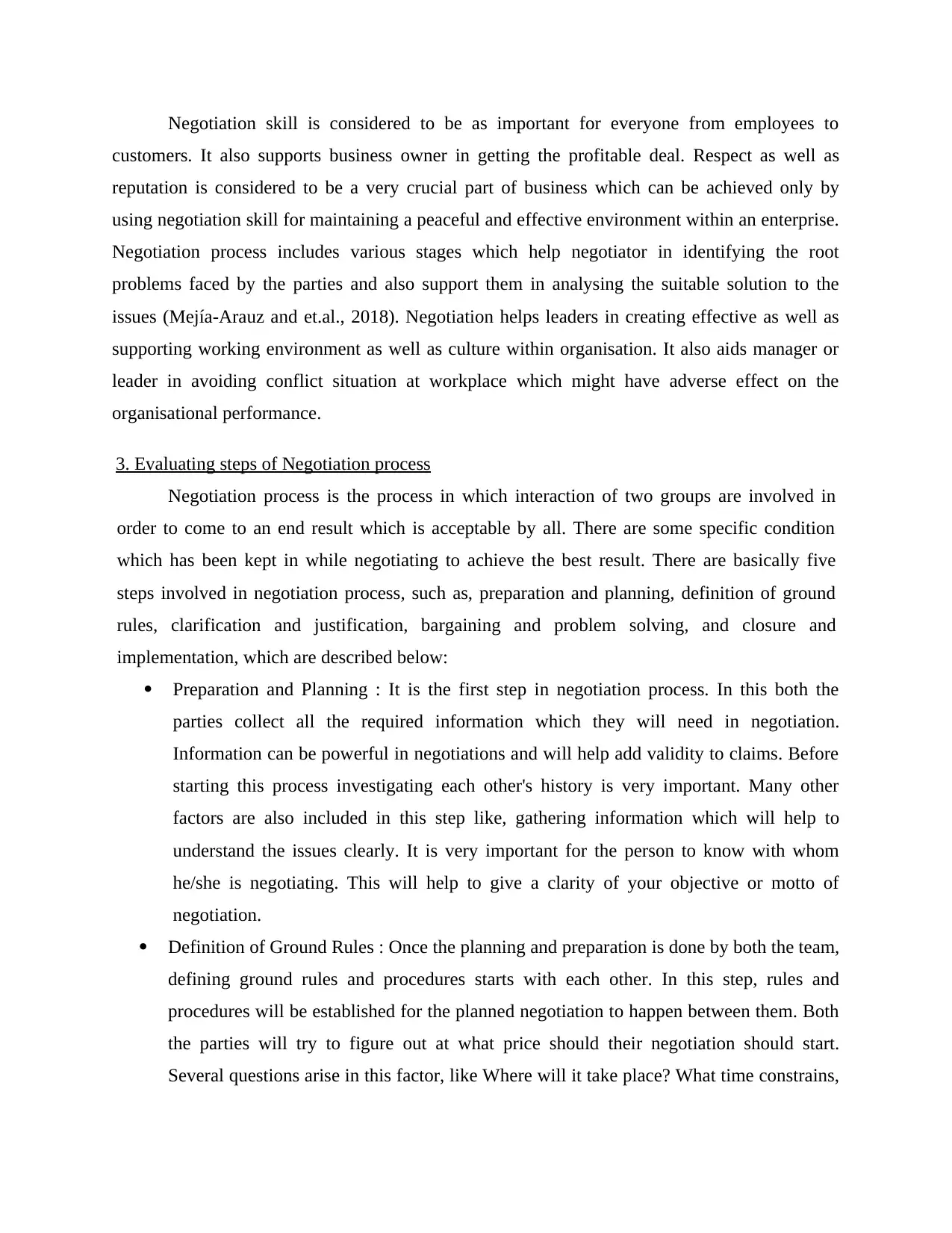
Negotiation skill is considered to be as important for everyone from employees to
customers. It also supports business owner in getting the profitable deal. Respect as well as
reputation is considered to be a very crucial part of business which can be achieved only by
using negotiation skill for maintaining a peaceful and effective environment within an enterprise.
Negotiation process includes various stages which help negotiator in identifying the root
problems faced by the parties and also support them in analysing the suitable solution to the
issues (Mejía-Arauz and et.al., 2018). Negotiation helps leaders in creating effective as well as
supporting working environment as well as culture within organisation. It also aids manager or
leader in avoiding conflict situation at workplace which might have adverse effect on the
organisational performance.
3. Evaluating steps of Negotiation process
Negotiation process is the process in which interaction of two groups are involved in
order to come to an end result which is acceptable by all. There are some specific condition
which has been kept in while negotiating to achieve the best result. There are basically five
steps involved in negotiation process, such as, preparation and planning, definition of ground
rules, clarification and justification, bargaining and problem solving, and closure and
implementation, which are described below:
Preparation and Planning : It is the first step in negotiation process. In this both the
parties collect all the required information which they will need in negotiation.
Information can be powerful in negotiations and will help add validity to claims. Before
starting this process investigating each other's history is very important. Many other
factors are also included in this step like, gathering information which will help to
understand the issues clearly. It is very important for the person to know with whom
he/she is negotiating. This will help to give a clarity of your objective or motto of
negotiation.
Definition of Ground Rules : Once the planning and preparation is done by both the team,
defining ground rules and procedures starts with each other. In this step, rules and
procedures will be established for the planned negotiation to happen between them. Both
the parties will try to figure out at what price should their negotiation should start.
Several questions arise in this factor, like Where will it take place? What time constrains,
customers. It also supports business owner in getting the profitable deal. Respect as well as
reputation is considered to be a very crucial part of business which can be achieved only by
using negotiation skill for maintaining a peaceful and effective environment within an enterprise.
Negotiation process includes various stages which help negotiator in identifying the root
problems faced by the parties and also support them in analysing the suitable solution to the
issues (Mejía-Arauz and et.al., 2018). Negotiation helps leaders in creating effective as well as
supporting working environment as well as culture within organisation. It also aids manager or
leader in avoiding conflict situation at workplace which might have adverse effect on the
organisational performance.
3. Evaluating steps of Negotiation process
Negotiation process is the process in which interaction of two groups are involved in
order to come to an end result which is acceptable by all. There are some specific condition
which has been kept in while negotiating to achieve the best result. There are basically five
steps involved in negotiation process, such as, preparation and planning, definition of ground
rules, clarification and justification, bargaining and problem solving, and closure and
implementation, which are described below:
Preparation and Planning : It is the first step in negotiation process. In this both the
parties collect all the required information which they will need in negotiation.
Information can be powerful in negotiations and will help add validity to claims. Before
starting this process investigating each other's history is very important. Many other
factors are also included in this step like, gathering information which will help to
understand the issues clearly. It is very important for the person to know with whom
he/she is negotiating. This will help to give a clarity of your objective or motto of
negotiation.
Definition of Ground Rules : Once the planning and preparation is done by both the team,
defining ground rules and procedures starts with each other. In this step, rules and
procedures will be established for the planned negotiation to happen between them. Both
the parties will try to figure out at what price should their negotiation should start.
Several questions arise in this factor, like Where will it take place? What time constrains,
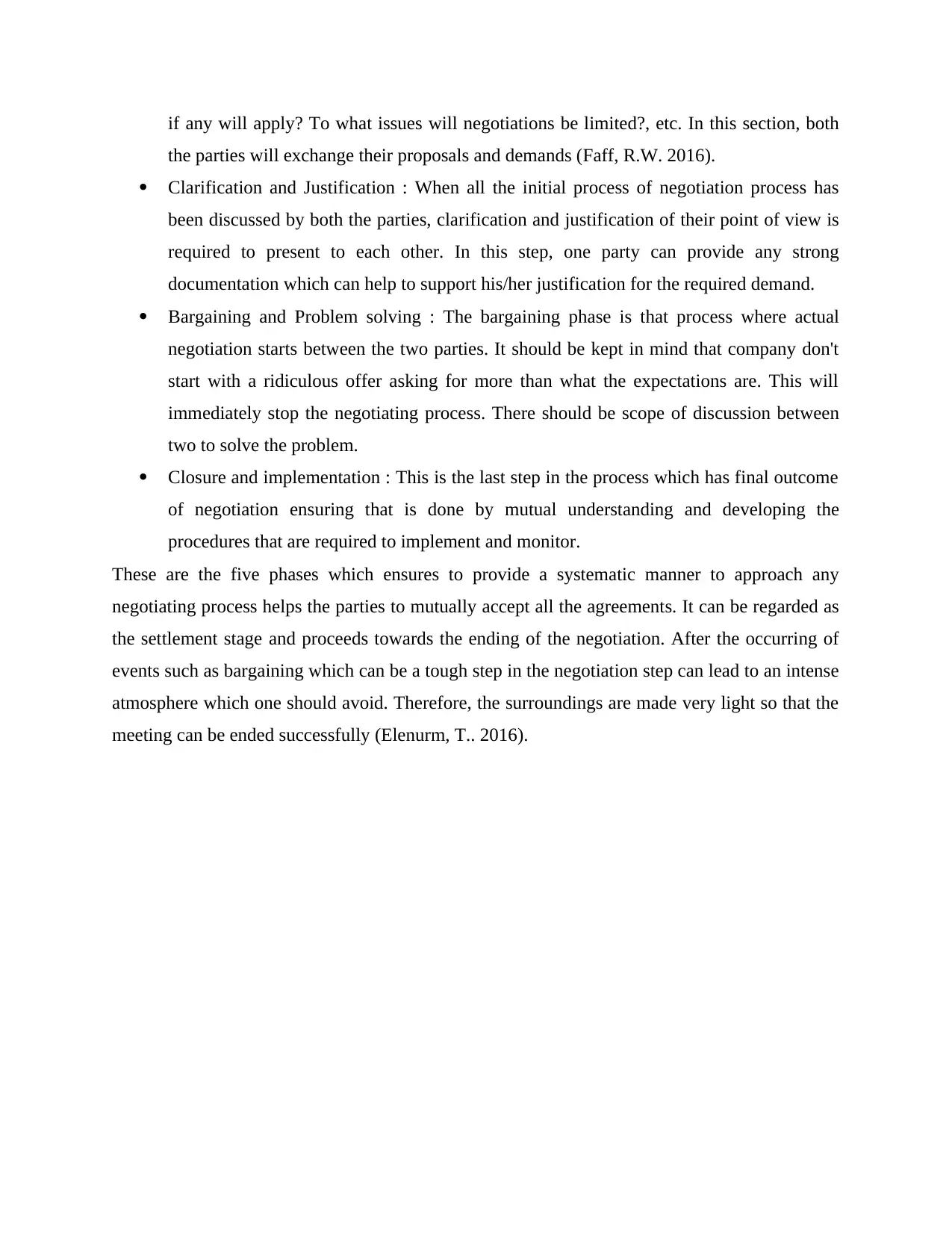
if any will apply? To what issues will negotiations be limited?, etc. In this section, both
the parties will exchange their proposals and demands (Faff, R.W. 2016).
Clarification and Justification : When all the initial process of negotiation process has
been discussed by both the parties, clarification and justification of their point of view is
required to present to each other. In this step, one party can provide any strong
documentation which can help to support his/her justification for the required demand.
Bargaining and Problem solving : The bargaining phase is that process where actual
negotiation starts between the two parties. It should be kept in mind that company don't
start with a ridiculous offer asking for more than what the expectations are. This will
immediately stop the negotiating process. There should be scope of discussion between
two to solve the problem.
Closure and implementation : This is the last step in the process which has final outcome
of negotiation ensuring that is done by mutual understanding and developing the
procedures that are required to implement and monitor.
These are the five phases which ensures to provide a systematic manner to approach any
negotiating process helps the parties to mutually accept all the agreements. It can be regarded as
the settlement stage and proceeds towards the ending of the negotiation. After the occurring of
events such as bargaining which can be a tough step in the negotiation step can lead to an intense
atmosphere which one should avoid. Therefore, the surroundings are made very light so that the
meeting can be ended successfully (Elenurm, T.. 2016).
the parties will exchange their proposals and demands (Faff, R.W. 2016).
Clarification and Justification : When all the initial process of negotiation process has
been discussed by both the parties, clarification and justification of their point of view is
required to present to each other. In this step, one party can provide any strong
documentation which can help to support his/her justification for the required demand.
Bargaining and Problem solving : The bargaining phase is that process where actual
negotiation starts between the two parties. It should be kept in mind that company don't
start with a ridiculous offer asking for more than what the expectations are. This will
immediately stop the negotiating process. There should be scope of discussion between
two to solve the problem.
Closure and implementation : This is the last step in the process which has final outcome
of negotiation ensuring that is done by mutual understanding and developing the
procedures that are required to implement and monitor.
These are the five phases which ensures to provide a systematic manner to approach any
negotiating process helps the parties to mutually accept all the agreements. It can be regarded as
the settlement stage and proceeds towards the ending of the negotiation. After the occurring of
events such as bargaining which can be a tough step in the negotiation step can lead to an intense
atmosphere which one should avoid. Therefore, the surroundings are made very light so that the
meeting can be ended successfully (Elenurm, T.. 2016).
Paraphrase This Document
Need a fresh take? Get an instant paraphrase of this document with our AI Paraphraser
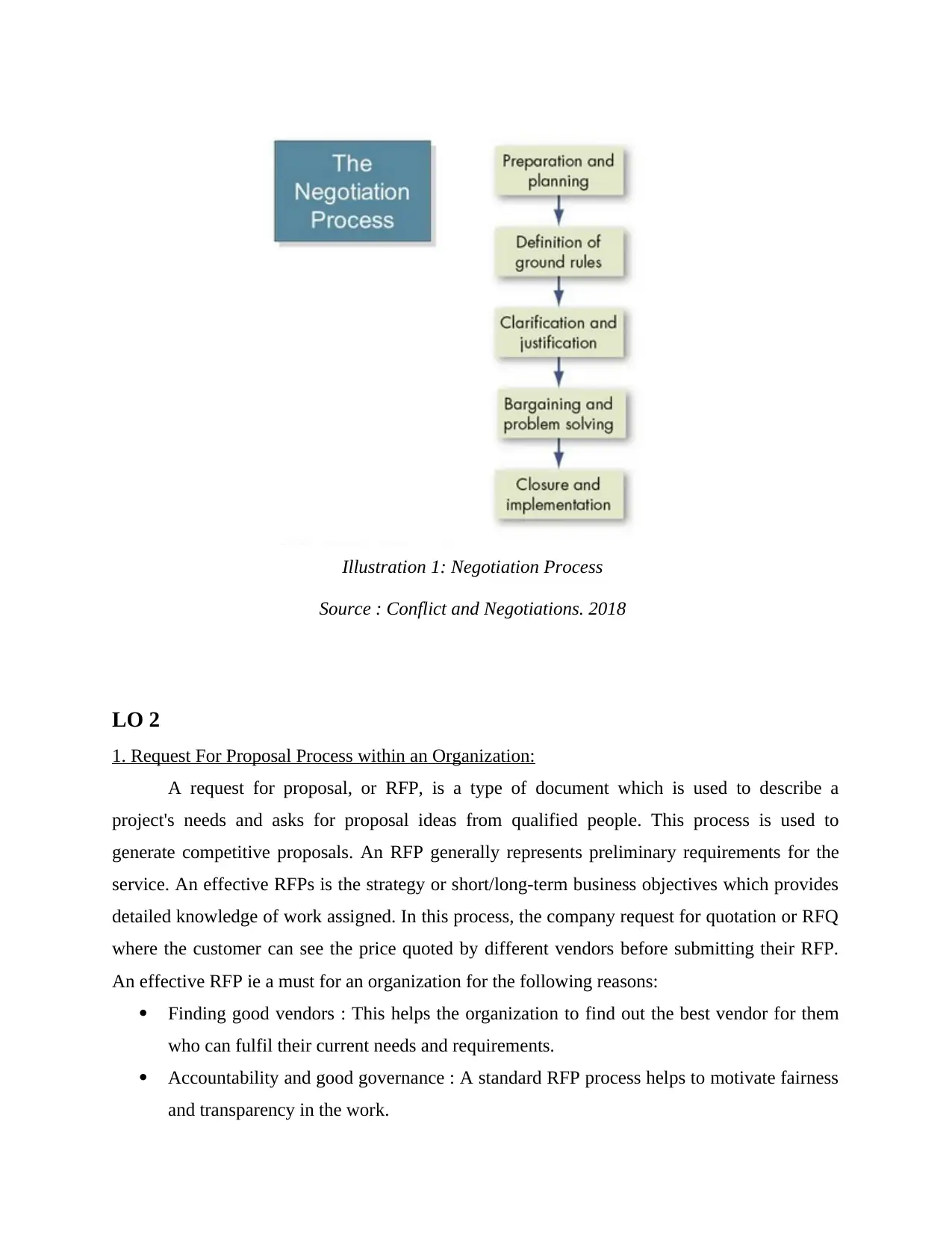
LO 2
1. Request For Proposal Process within an Organization:
A request for proposal, or RFP, is a type of document which is used to describe a
project's needs and asks for proposal ideas from qualified people. This process is used to
generate competitive proposals. An RFP generally represents preliminary requirements for the
service. An effective RFPs is the strategy or short/long-term business objectives which provides
detailed knowledge of work assigned. In this process, the company request for quotation or RFQ
where the customer can see the price quoted by different vendors before submitting their RFP.
An effective RFP ie a must for an organization for the following reasons:
Finding good vendors : This helps the organization to find out the best vendor for them
who can fulfil their current needs and requirements.
Accountability and good governance : A standard RFP process helps to motivate fairness
and transparency in the work.
Illustration 1: Negotiation Process
Source : Conflict and Negotiations. 2018
1. Request For Proposal Process within an Organization:
A request for proposal, or RFP, is a type of document which is used to describe a
project's needs and asks for proposal ideas from qualified people. This process is used to
generate competitive proposals. An RFP generally represents preliminary requirements for the
service. An effective RFPs is the strategy or short/long-term business objectives which provides
detailed knowledge of work assigned. In this process, the company request for quotation or RFQ
where the customer can see the price quoted by different vendors before submitting their RFP.
An effective RFP ie a must for an organization for the following reasons:
Finding good vendors : This helps the organization to find out the best vendor for them
who can fulfil their current needs and requirements.
Accountability and good governance : A standard RFP process helps to motivate fairness
and transparency in the work.
Illustration 1: Negotiation Process
Source : Conflict and Negotiations. 2018
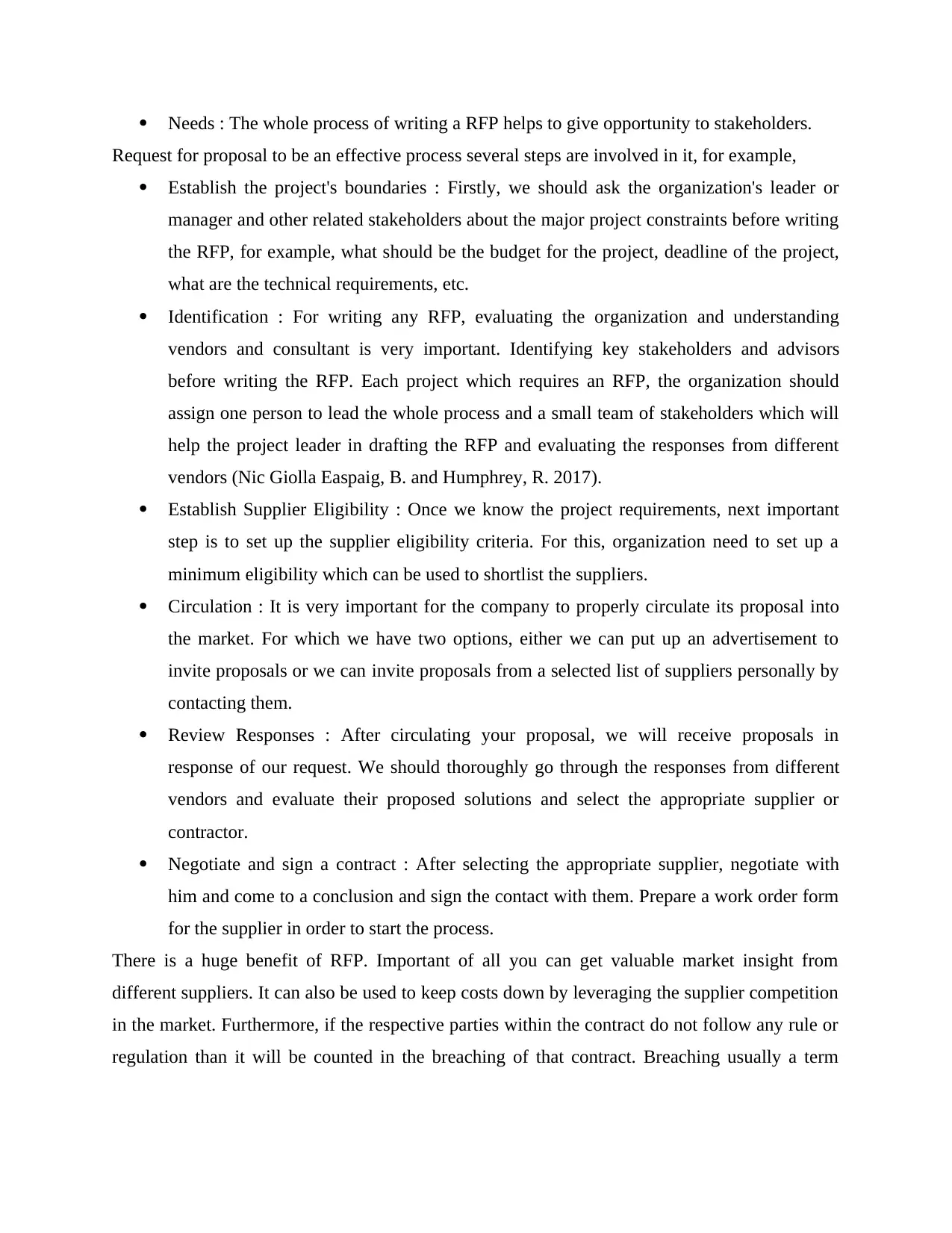
Needs : The whole process of writing a RFP helps to give opportunity to stakeholders.
Request for proposal to be an effective process several steps are involved in it, for example,
Establish the project's boundaries : Firstly, we should ask the organization's leader or
manager and other related stakeholders about the major project constraints before writing
the RFP, for example, what should be the budget for the project, deadline of the project,
what are the technical requirements, etc.
Identification : For writing any RFP, evaluating the organization and understanding
vendors and consultant is very important. Identifying key stakeholders and advisors
before writing the RFP. Each project which requires an RFP, the organization should
assign one person to lead the whole process and a small team of stakeholders which will
help the project leader in drafting the RFP and evaluating the responses from different
vendors (Nic Giolla Easpaig, B. and Humphrey, R. 2017).
Establish Supplier Eligibility : Once we know the project requirements, next important
step is to set up the supplier eligibility criteria. For this, organization need to set up a
minimum eligibility which can be used to shortlist the suppliers.
Circulation : It is very important for the company to properly circulate its proposal into
the market. For which we have two options, either we can put up an advertisement to
invite proposals or we can invite proposals from a selected list of suppliers personally by
contacting them.
Review Responses : After circulating your proposal, we will receive proposals in
response of our request. We should thoroughly go through the responses from different
vendors and evaluate their proposed solutions and select the appropriate supplier or
contractor.
Negotiate and sign a contract : After selecting the appropriate supplier, negotiate with
him and come to a conclusion and sign the contact with them. Prepare a work order form
for the supplier in order to start the process.
There is a huge benefit of RFP. Important of all you can get valuable market insight from
different suppliers. It can also be used to keep costs down by leveraging the supplier competition
in the market. Furthermore, if the respective parties within the contract do not follow any rule or
regulation than it will be counted in the breaching of that contract. Breaching usually a term
Request for proposal to be an effective process several steps are involved in it, for example,
Establish the project's boundaries : Firstly, we should ask the organization's leader or
manager and other related stakeholders about the major project constraints before writing
the RFP, for example, what should be the budget for the project, deadline of the project,
what are the technical requirements, etc.
Identification : For writing any RFP, evaluating the organization and understanding
vendors and consultant is very important. Identifying key stakeholders and advisors
before writing the RFP. Each project which requires an RFP, the organization should
assign one person to lead the whole process and a small team of stakeholders which will
help the project leader in drafting the RFP and evaluating the responses from different
vendors (Nic Giolla Easpaig, B. and Humphrey, R. 2017).
Establish Supplier Eligibility : Once we know the project requirements, next important
step is to set up the supplier eligibility criteria. For this, organization need to set up a
minimum eligibility which can be used to shortlist the suppliers.
Circulation : It is very important for the company to properly circulate its proposal into
the market. For which we have two options, either we can put up an advertisement to
invite proposals or we can invite proposals from a selected list of suppliers personally by
contacting them.
Review Responses : After circulating your proposal, we will receive proposals in
response of our request. We should thoroughly go through the responses from different
vendors and evaluate their proposed solutions and select the appropriate supplier or
contractor.
Negotiate and sign a contract : After selecting the appropriate supplier, negotiate with
him and come to a conclusion and sign the contact with them. Prepare a work order form
for the supplier in order to start the process.
There is a huge benefit of RFP. Important of all you can get valuable market insight from
different suppliers. It can also be used to keep costs down by leveraging the supplier competition
in the market. Furthermore, if the respective parties within the contract do not follow any rule or
regulation than it will be counted in the breaching of that contract. Breaching usually a term
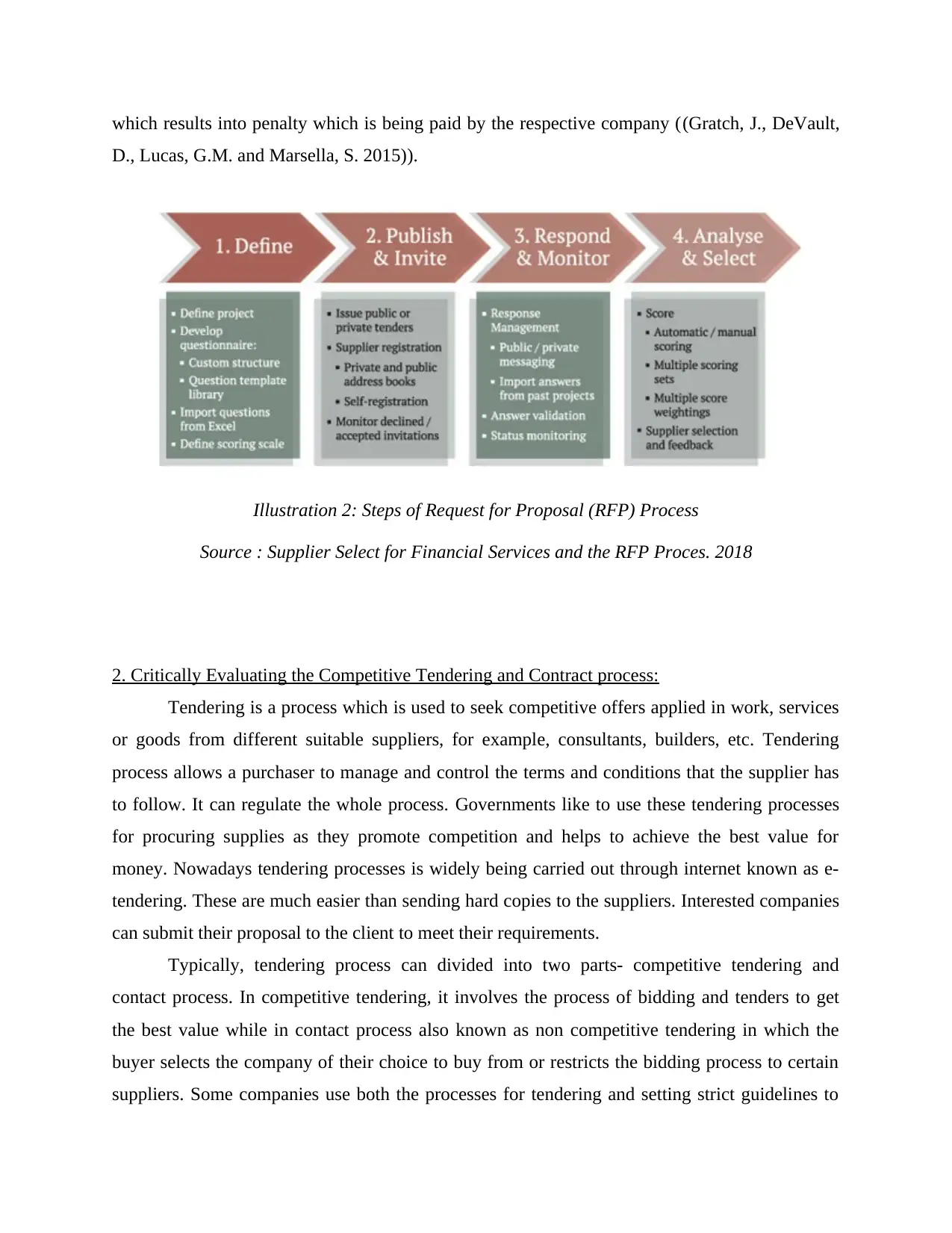
which results into penalty which is being paid by the respective company ((Gratch, J., DeVault,
D., Lucas, G.M. and Marsella, S. 2015)).
2. Critically Evaluating the Competitive Tendering and Contract process:
Tendering is a process which is used to seek competitive offers applied in work, services
or goods from different suitable suppliers, for example, consultants, builders, etc. Tendering
process allows a purchaser to manage and control the terms and conditions that the supplier has
to follow. It can regulate the whole process. Governments like to use these tendering processes
for procuring supplies as they promote competition and helps to achieve the best value for
money. Nowadays tendering processes is widely being carried out through internet known as e-
tendering. These are much easier than sending hard copies to the suppliers. Interested companies
can submit their proposal to the client to meet their requirements.
Typically, tendering process can divided into two parts- competitive tendering and
contact process. In competitive tendering, it involves the process of bidding and tenders to get
the best value while in contact process also known as non competitive tendering in which the
buyer selects the company of their choice to buy from or restricts the bidding process to certain
suppliers. Some companies use both the processes for tendering and setting strict guidelines to
Illustration 2: Steps of Request for Proposal (RFP) Process
Source : Supplier Select for Financial Services and the RFP Proces. 2018
D., Lucas, G.M. and Marsella, S. 2015)).
2. Critically Evaluating the Competitive Tendering and Contract process:
Tendering is a process which is used to seek competitive offers applied in work, services
or goods from different suitable suppliers, for example, consultants, builders, etc. Tendering
process allows a purchaser to manage and control the terms and conditions that the supplier has
to follow. It can regulate the whole process. Governments like to use these tendering processes
for procuring supplies as they promote competition and helps to achieve the best value for
money. Nowadays tendering processes is widely being carried out through internet known as e-
tendering. These are much easier than sending hard copies to the suppliers. Interested companies
can submit their proposal to the client to meet their requirements.
Typically, tendering process can divided into two parts- competitive tendering and
contact process. In competitive tendering, it involves the process of bidding and tenders to get
the best value while in contact process also known as non competitive tendering in which the
buyer selects the company of their choice to buy from or restricts the bidding process to certain
suppliers. Some companies use both the processes for tendering and setting strict guidelines to
Illustration 2: Steps of Request for Proposal (RFP) Process
Source : Supplier Select for Financial Services and the RFP Proces. 2018
Secure Best Marks with AI Grader
Need help grading? Try our AI Grader for instant feedback on your assignments.
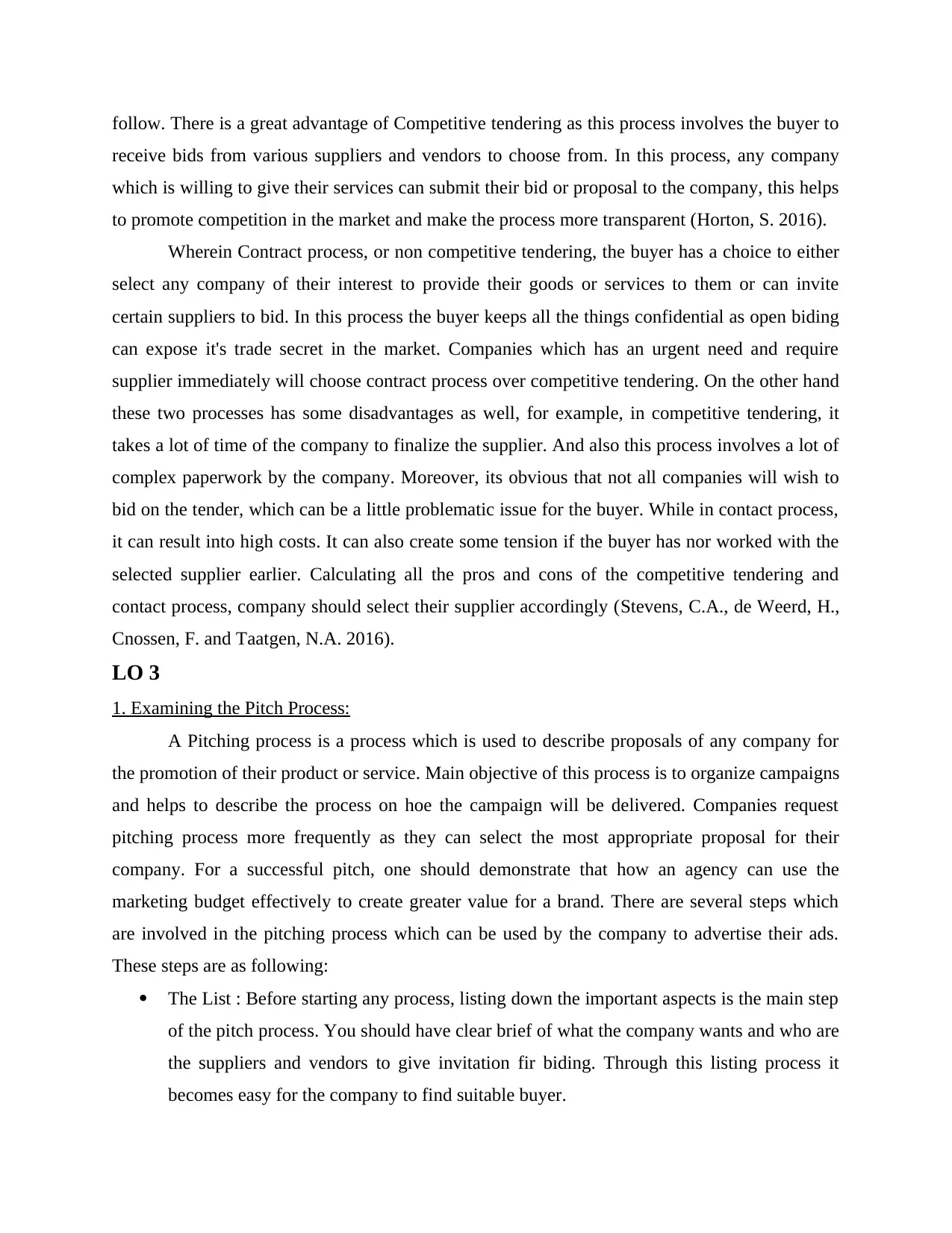
follow. There is a great advantage of Competitive tendering as this process involves the buyer to
receive bids from various suppliers and vendors to choose from. In this process, any company
which is willing to give their services can submit their bid or proposal to the company, this helps
to promote competition in the market and make the process more transparent (Horton, S. 2016).
Wherein Contract process, or non competitive tendering, the buyer has a choice to either
select any company of their interest to provide their goods or services to them or can invite
certain suppliers to bid. In this process the buyer keeps all the things confidential as open biding
can expose it's trade secret in the market. Companies which has an urgent need and require
supplier immediately will choose contract process over competitive tendering. On the other hand
these two processes has some disadvantages as well, for example, in competitive tendering, it
takes a lot of time of the company to finalize the supplier. And also this process involves a lot of
complex paperwork by the company. Moreover, its obvious that not all companies will wish to
bid on the tender, which can be a little problematic issue for the buyer. While in contact process,
it can result into high costs. It can also create some tension if the buyer has nor worked with the
selected supplier earlier. Calculating all the pros and cons of the competitive tendering and
contact process, company should select their supplier accordingly (Stevens, C.A., de Weerd, H.,
Cnossen, F. and Taatgen, N.A. 2016).
LO 3
1. Examining the Pitch Process:
A Pitching process is a process which is used to describe proposals of any company for
the promotion of their product or service. Main objective of this process is to organize campaigns
and helps to describe the process on hoe the campaign will be delivered. Companies request
pitching process more frequently as they can select the most appropriate proposal for their
company. For a successful pitch, one should demonstrate that how an agency can use the
marketing budget effectively to create greater value for a brand. There are several steps which
are involved in the pitching process which can be used by the company to advertise their ads.
These steps are as following:
The List : Before starting any process, listing down the important aspects is the main step
of the pitch process. You should have clear brief of what the company wants and who are
the suppliers and vendors to give invitation fir biding. Through this listing process it
becomes easy for the company to find suitable buyer.
receive bids from various suppliers and vendors to choose from. In this process, any company
which is willing to give their services can submit their bid or proposal to the company, this helps
to promote competition in the market and make the process more transparent (Horton, S. 2016).
Wherein Contract process, or non competitive tendering, the buyer has a choice to either
select any company of their interest to provide their goods or services to them or can invite
certain suppliers to bid. In this process the buyer keeps all the things confidential as open biding
can expose it's trade secret in the market. Companies which has an urgent need and require
supplier immediately will choose contract process over competitive tendering. On the other hand
these two processes has some disadvantages as well, for example, in competitive tendering, it
takes a lot of time of the company to finalize the supplier. And also this process involves a lot of
complex paperwork by the company. Moreover, its obvious that not all companies will wish to
bid on the tender, which can be a little problematic issue for the buyer. While in contact process,
it can result into high costs. It can also create some tension if the buyer has nor worked with the
selected supplier earlier. Calculating all the pros and cons of the competitive tendering and
contact process, company should select their supplier accordingly (Stevens, C.A., de Weerd, H.,
Cnossen, F. and Taatgen, N.A. 2016).
LO 3
1. Examining the Pitch Process:
A Pitching process is a process which is used to describe proposals of any company for
the promotion of their product or service. Main objective of this process is to organize campaigns
and helps to describe the process on hoe the campaign will be delivered. Companies request
pitching process more frequently as they can select the most appropriate proposal for their
company. For a successful pitch, one should demonstrate that how an agency can use the
marketing budget effectively to create greater value for a brand. There are several steps which
are involved in the pitching process which can be used by the company to advertise their ads.
These steps are as following:
The List : Before starting any process, listing down the important aspects is the main step
of the pitch process. You should have clear brief of what the company wants and who are
the suppliers and vendors to give invitation fir biding. Through this listing process it
becomes easy for the company to find suitable buyer.
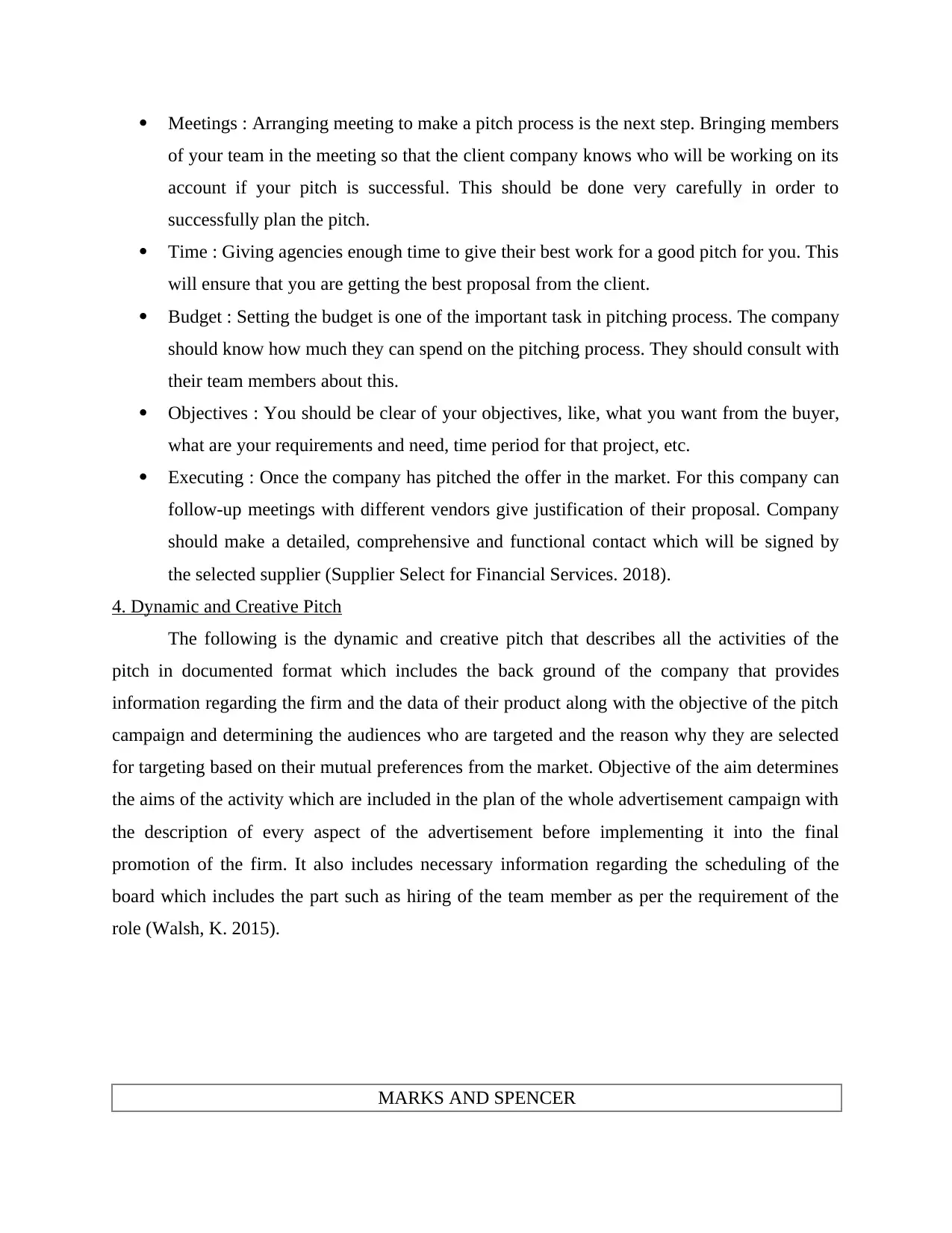
Meetings : Arranging meeting to make a pitch process is the next step. Bringing members
of your team in the meeting so that the client company knows who will be working on its
account if your pitch is successful. This should be done very carefully in order to
successfully plan the pitch.
Time : Giving agencies enough time to give their best work for a good pitch for you. This
will ensure that you are getting the best proposal from the client.
Budget : Setting the budget is one of the important task in pitching process. The company
should know how much they can spend on the pitching process. They should consult with
their team members about this.
Objectives : You should be clear of your objectives, like, what you want from the buyer,
what are your requirements and need, time period for that project, etc.
Executing : Once the company has pitched the offer in the market. For this company can
follow-up meetings with different vendors give justification of their proposal. Company
should make a detailed, comprehensive and functional contact which will be signed by
the selected supplier (Supplier Select for Financial Services. 2018).
4. Dynamic and Creative Pitch
The following is the dynamic and creative pitch that describes all the activities of the
pitch in documented format which includes the back ground of the company that provides
information regarding the firm and the data of their product along with the objective of the pitch
campaign and determining the audiences who are targeted and the reason why they are selected
for targeting based on their mutual preferences from the market. Objective of the aim determines
the aims of the activity which are included in the plan of the whole advertisement campaign with
the description of every aspect of the advertisement before implementing it into the final
promotion of the firm. It also includes necessary information regarding the scheduling of the
board which includes the part such as hiring of the team member as per the requirement of the
role (Walsh, K. 2015).
MARKS AND SPENCER
of your team in the meeting so that the client company knows who will be working on its
account if your pitch is successful. This should be done very carefully in order to
successfully plan the pitch.
Time : Giving agencies enough time to give their best work for a good pitch for you. This
will ensure that you are getting the best proposal from the client.
Budget : Setting the budget is one of the important task in pitching process. The company
should know how much they can spend on the pitching process. They should consult with
their team members about this.
Objectives : You should be clear of your objectives, like, what you want from the buyer,
what are your requirements and need, time period for that project, etc.
Executing : Once the company has pitched the offer in the market. For this company can
follow-up meetings with different vendors give justification of their proposal. Company
should make a detailed, comprehensive and functional contact which will be signed by
the selected supplier (Supplier Select for Financial Services. 2018).
4. Dynamic and Creative Pitch
The following is the dynamic and creative pitch that describes all the activities of the
pitch in documented format which includes the back ground of the company that provides
information regarding the firm and the data of their product along with the objective of the pitch
campaign and determining the audiences who are targeted and the reason why they are selected
for targeting based on their mutual preferences from the market. Objective of the aim determines
the aims of the activity which are included in the plan of the whole advertisement campaign with
the description of every aspect of the advertisement before implementing it into the final
promotion of the firm. It also includes necessary information regarding the scheduling of the
board which includes the part such as hiring of the team member as per the requirement of the
role (Walsh, K. 2015).
MARKS AND SPENCER
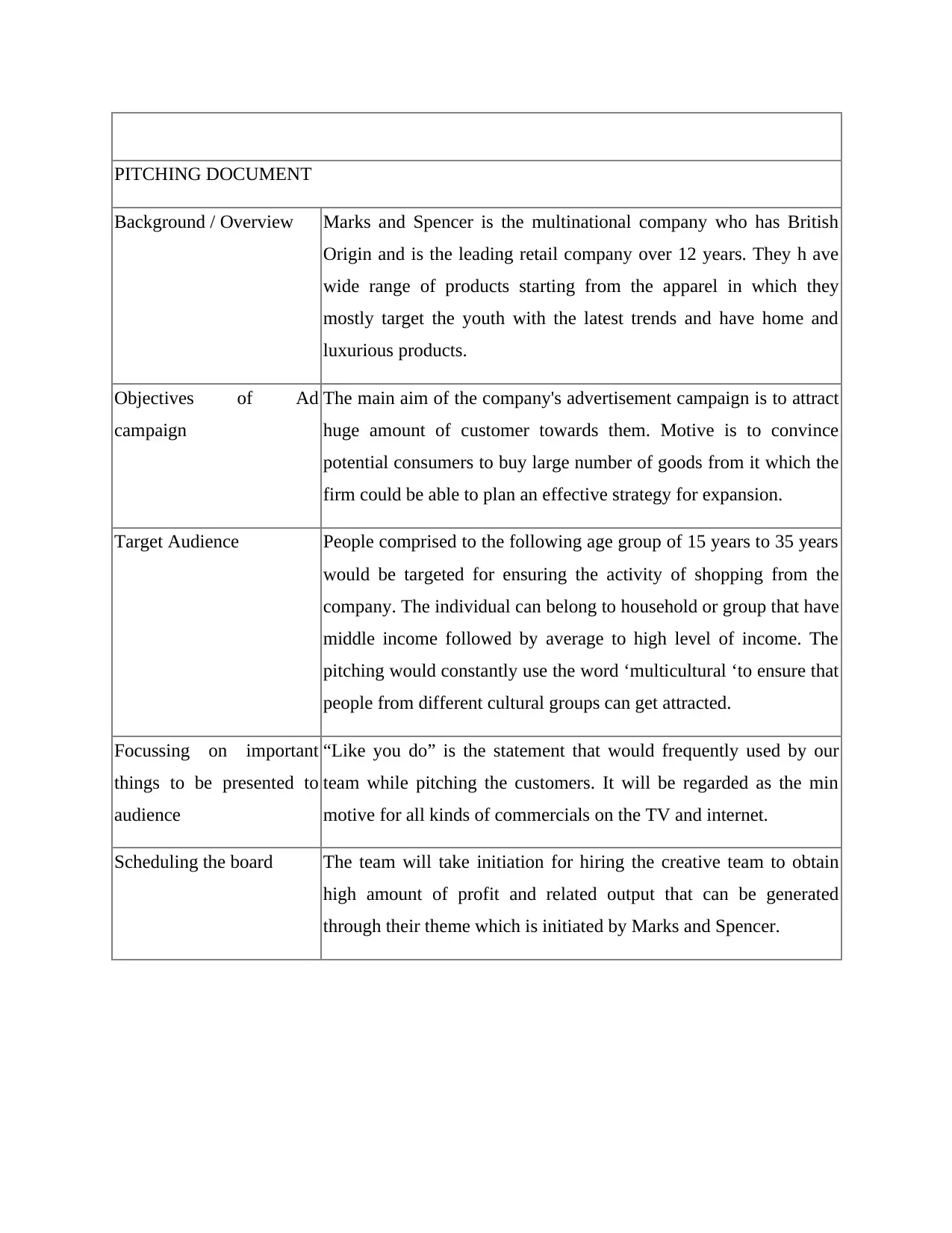
PITCHING DOCUMENT
Background / Overview Marks and Spencer is the multinational company who has British
Origin and is the leading retail company over 12 years. They h ave
wide range of products starting from the apparel in which they
mostly target the youth with the latest trends and have home and
luxurious products.
Objectives of Ad
campaign
The main aim of the company's advertisement campaign is to attract
huge amount of customer towards them. Motive is to convince
potential consumers to buy large number of goods from it which the
firm could be able to plan an effective strategy for expansion.
Target Audience People comprised to the following age group of 15 years to 35 years
would be targeted for ensuring the activity of shopping from the
company. The individual can belong to household or group that have
middle income followed by average to high level of income. The
pitching would constantly use the word ‘multicultural ‘to ensure that
people from different cultural groups can get attracted.
Focussing on important
things to be presented to
audience
“Like you do” is the statement that would frequently used by our
team while pitching the customers. It will be regarded as the min
motive for all kinds of commercials on the TV and internet.
Scheduling the board The team will take initiation for hiring the creative team to obtain
high amount of profit and related output that can be generated
through their theme which is initiated by Marks and Spencer.
Background / Overview Marks and Spencer is the multinational company who has British
Origin and is the leading retail company over 12 years. They h ave
wide range of products starting from the apparel in which they
mostly target the youth with the latest trends and have home and
luxurious products.
Objectives of Ad
campaign
The main aim of the company's advertisement campaign is to attract
huge amount of customer towards them. Motive is to convince
potential consumers to buy large number of goods from it which the
firm could be able to plan an effective strategy for expansion.
Target Audience People comprised to the following age group of 15 years to 35 years
would be targeted for ensuring the activity of shopping from the
company. The individual can belong to household or group that have
middle income followed by average to high level of income. The
pitching would constantly use the word ‘multicultural ‘to ensure that
people from different cultural groups can get attracted.
Focussing on important
things to be presented to
audience
“Like you do” is the statement that would frequently used by our
team while pitching the customers. It will be regarded as the min
motive for all kinds of commercials on the TV and internet.
Scheduling the board The team will take initiation for hiring the creative team to obtain
high amount of profit and related output that can be generated
through their theme which is initiated by Marks and Spencer.
Paraphrase This Document
Need a fresh take? Get an instant paraphrase of this document with our AI Paraphraser
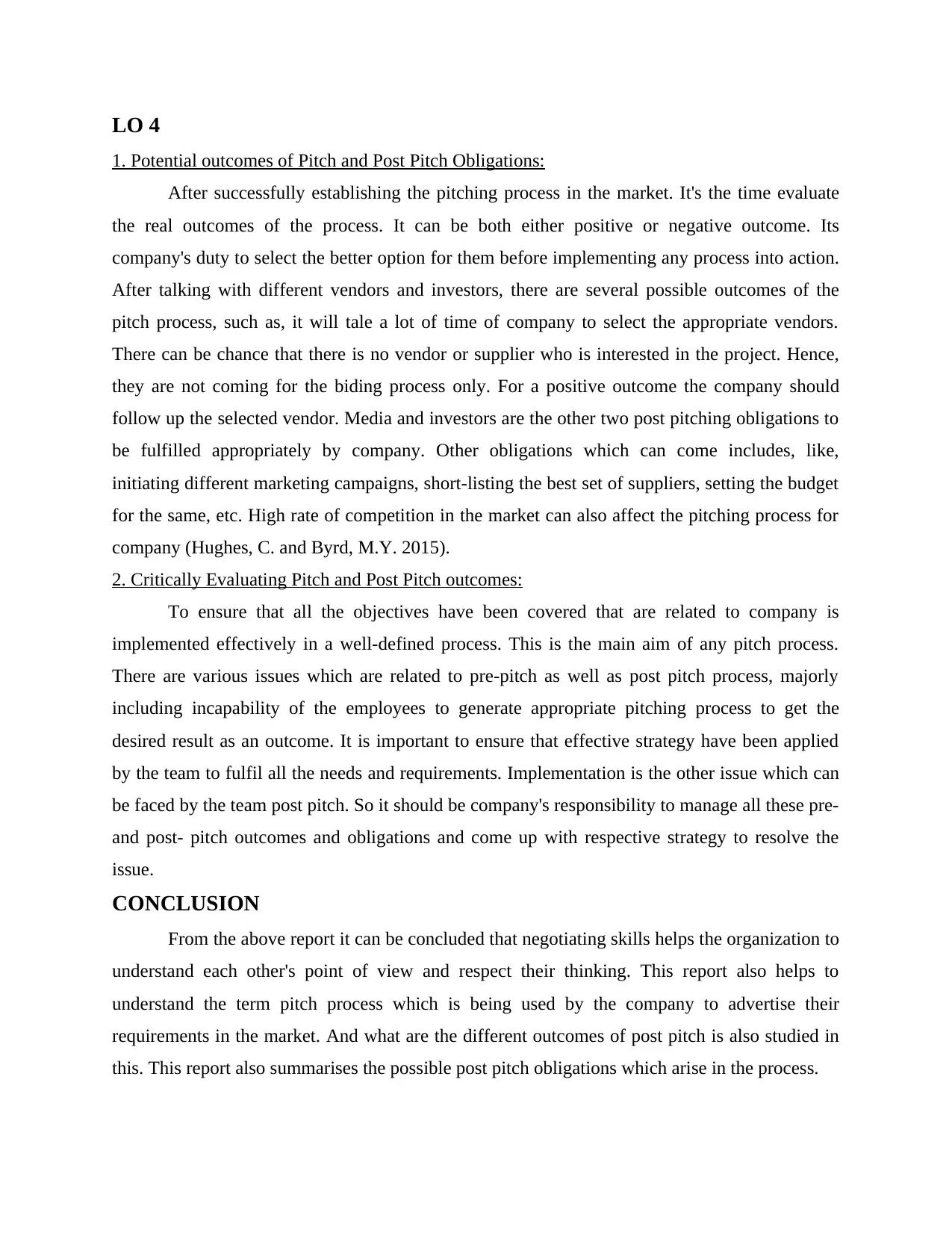
LO 4
1. Potential outcomes of Pitch and Post Pitch Obligations:
After successfully establishing the pitching process in the market. It's the time evaluate
the real outcomes of the process. It can be both either positive or negative outcome. Its
company's duty to select the better option for them before implementing any process into action.
After talking with different vendors and investors, there are several possible outcomes of the
pitch process, such as, it will tale a lot of time of company to select the appropriate vendors.
There can be chance that there is no vendor or supplier who is interested in the project. Hence,
they are not coming for the biding process only. For a positive outcome the company should
follow up the selected vendor. Media and investors are the other two post pitching obligations to
be fulfilled appropriately by company. Other obligations which can come includes, like,
initiating different marketing campaigns, short-listing the best set of suppliers, setting the budget
for the same, etc. High rate of competition in the market can also affect the pitching process for
company (Hughes, C. and Byrd, M.Y. 2015).
2. Critically Evaluating Pitch and Post Pitch outcomes:
To ensure that all the objectives have been covered that are related to company is
implemented effectively in a well-defined process. This is the main aim of any pitch process.
There are various issues which are related to pre-pitch as well as post pitch process, majorly
including incapability of the employees to generate appropriate pitching process to get the
desired result as an outcome. It is important to ensure that effective strategy have been applied
by the team to fulfil all the needs and requirements. Implementation is the other issue which can
be faced by the team post pitch. So it should be company's responsibility to manage all these pre-
and post- pitch outcomes and obligations and come up with respective strategy to resolve the
issue.
CONCLUSION
From the above report it can be concluded that negotiating skills helps the organization to
understand each other's point of view and respect their thinking. This report also helps to
understand the term pitch process which is being used by the company to advertise their
requirements in the market. And what are the different outcomes of post pitch is also studied in
this. This report also summarises the possible post pitch obligations which arise in the process.
1. Potential outcomes of Pitch and Post Pitch Obligations:
After successfully establishing the pitching process in the market. It's the time evaluate
the real outcomes of the process. It can be both either positive or negative outcome. Its
company's duty to select the better option for them before implementing any process into action.
After talking with different vendors and investors, there are several possible outcomes of the
pitch process, such as, it will tale a lot of time of company to select the appropriate vendors.
There can be chance that there is no vendor or supplier who is interested in the project. Hence,
they are not coming for the biding process only. For a positive outcome the company should
follow up the selected vendor. Media and investors are the other two post pitching obligations to
be fulfilled appropriately by company. Other obligations which can come includes, like,
initiating different marketing campaigns, short-listing the best set of suppliers, setting the budget
for the same, etc. High rate of competition in the market can also affect the pitching process for
company (Hughes, C. and Byrd, M.Y. 2015).
2. Critically Evaluating Pitch and Post Pitch outcomes:
To ensure that all the objectives have been covered that are related to company is
implemented effectively in a well-defined process. This is the main aim of any pitch process.
There are various issues which are related to pre-pitch as well as post pitch process, majorly
including incapability of the employees to generate appropriate pitching process to get the
desired result as an outcome. It is important to ensure that effective strategy have been applied
by the team to fulfil all the needs and requirements. Implementation is the other issue which can
be faced by the team post pitch. So it should be company's responsibility to manage all these pre-
and post- pitch outcomes and obligations and come up with respective strategy to resolve the
issue.
CONCLUSION
From the above report it can be concluded that negotiating skills helps the organization to
understand each other's point of view and respect their thinking. This report also helps to
understand the term pitch process which is being used by the company to advertise their
requirements in the market. And what are the different outcomes of post pitch is also studied in
this. This report also summarises the possible post pitch obligations which arise in the process.
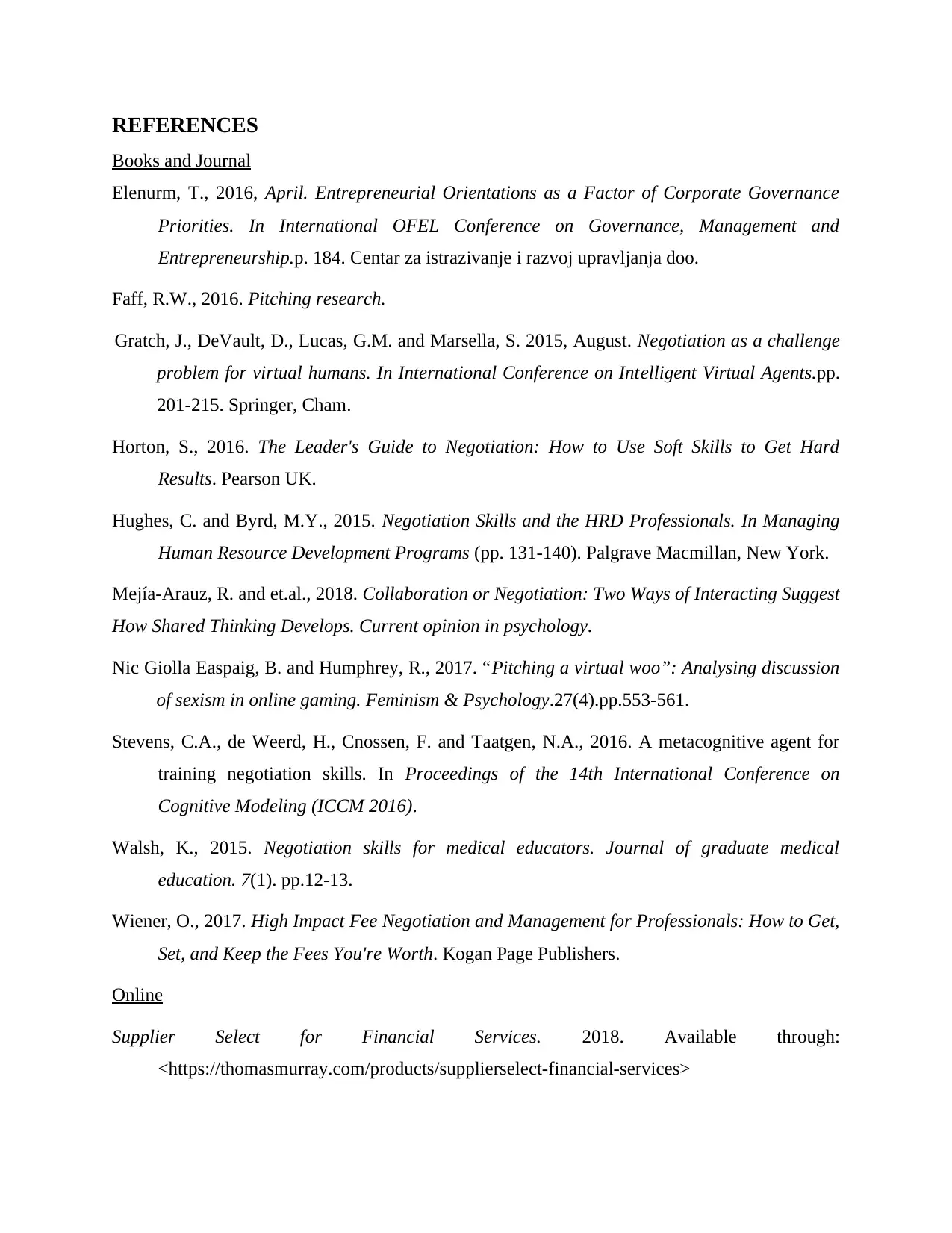
REFERENCES
Books and Journal
Elenurm, T., 2016, April. Entrepreneurial Orientations as a Factor of Corporate Governance
Priorities. In International OFEL Conference on Governance, Management and
Entrepreneurship.p. 184. Centar za istrazivanje i razvoj upravljanja doo.
Faff, R.W., 2016. Pitching research.
Gratch, J., DeVault, D., Lucas, G.M. and Marsella, S. 2015, August. Negotiation as a challenge
problem for virtual humans. In International Conference on Intelligent Virtual Agents.pp.
201-215. Springer, Cham.
Horton, S., 2016. The Leader's Guide to Negotiation: How to Use Soft Skills to Get Hard
Results. Pearson UK.
Hughes, C. and Byrd, M.Y., 2015. Negotiation Skills and the HRD Professionals. In Managing
Human Resource Development Programs (pp. 131-140). Palgrave Macmillan, New York.
Mejía-Arauz, R. and et.al., 2018. Collaboration or Negotiation: Two Ways of Interacting Suggest
How Shared Thinking Develops. Current opinion in psychology.
Nic Giolla Easpaig, B. and Humphrey, R., 2017. “Pitching a virtual woo”: Analysing discussion
of sexism in online gaming. Feminism & Psychology.27(4).pp.553-561.
Stevens, C.A., de Weerd, H., Cnossen, F. and Taatgen, N.A., 2016. A metacognitive agent for
training negotiation skills. In Proceedings of the 14th International Conference on
Cognitive Modeling (ICCM 2016).
Walsh, K., 2015. Negotiation skills for medical educators. Journal of graduate medical
education. 7(1). pp.12-13.
Wiener, O., 2017. High Impact Fee Negotiation and Management for Professionals: How to Get,
Set, and Keep the Fees You're Worth. Kogan Page Publishers.
Online
Supplier Select for Financial Services. 2018. Available through:
<https://thomasmurray.com/products/supplierselect-financial-services>
Books and Journal
Elenurm, T., 2016, April. Entrepreneurial Orientations as a Factor of Corporate Governance
Priorities. In International OFEL Conference on Governance, Management and
Entrepreneurship.p. 184. Centar za istrazivanje i razvoj upravljanja doo.
Faff, R.W., 2016. Pitching research.
Gratch, J., DeVault, D., Lucas, G.M. and Marsella, S. 2015, August. Negotiation as a challenge
problem for virtual humans. In International Conference on Intelligent Virtual Agents.pp.
201-215. Springer, Cham.
Horton, S., 2016. The Leader's Guide to Negotiation: How to Use Soft Skills to Get Hard
Results. Pearson UK.
Hughes, C. and Byrd, M.Y., 2015. Negotiation Skills and the HRD Professionals. In Managing
Human Resource Development Programs (pp. 131-140). Palgrave Macmillan, New York.
Mejía-Arauz, R. and et.al., 2018. Collaboration or Negotiation: Two Ways of Interacting Suggest
How Shared Thinking Develops. Current opinion in psychology.
Nic Giolla Easpaig, B. and Humphrey, R., 2017. “Pitching a virtual woo”: Analysing discussion
of sexism in online gaming. Feminism & Psychology.27(4).pp.553-561.
Stevens, C.A., de Weerd, H., Cnossen, F. and Taatgen, N.A., 2016. A metacognitive agent for
training negotiation skills. In Proceedings of the 14th International Conference on
Cognitive Modeling (ICCM 2016).
Walsh, K., 2015. Negotiation skills for medical educators. Journal of graduate medical
education. 7(1). pp.12-13.
Wiener, O., 2017. High Impact Fee Negotiation and Management for Professionals: How to Get,
Set, and Keep the Fees You're Worth. Kogan Page Publishers.
Online
Supplier Select for Financial Services. 2018. Available through:
<https://thomasmurray.com/products/supplierselect-financial-services>
1 out of 15
Related Documents
Your All-in-One AI-Powered Toolkit for Academic Success.
+13062052269
info@desklib.com
Available 24*7 on WhatsApp / Email
![[object Object]](/_next/static/media/star-bottom.7253800d.svg)
Unlock your academic potential
© 2024 | Zucol Services PVT LTD | All rights reserved.





